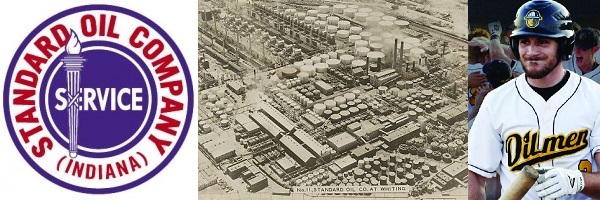Rockefeller’s Standard Oil scientists patented the “thermal cracking” process.
Beginning in the 1890s, the Whiting refinery of Standard Oil Company of Indiana first produced kerosene for lamps and later gasoline for autos to meet growing consumer demand.
Seventeen miles east of Chicago, Standard Oil Company of New Jersey began construction on a massive refinery complex in early May 1889. Using advanced refining processes introduced by John D. Rockefeller, it would become the largest in the United States.

BP completed a multi-year, multi-billion dollar modernization project at the Whiting refinery in 2013. Photo courtesy Hydrocarbon Processing magazine.
Once operated by Amoco, the refinery in Whiting, Indiana, was acquired by the British Petroleum Company in 1998 as part of its $48.2 billion merger with Amoco. After the acquisition, British Petroleum became BP Amoco, a name shorted to BP in 2001 after mergers with ARCO and Castrol.
The BP brand also used a lower-case bp often with the tagline “beyond petroleum” and a stylized yellow and green sun. By 2023 — and after federally mandated environmental improvements — the 1,400-acre Whiting plant refined about 435,000 barrels of oil per day.
Refining “Sour Crude”
About one month after construction of the then 235-acre refinery began, Rockefeller established a locally based subsidiary by incorporating Standard Oil Company of Indiana on June 18, 1889. The new company began processing oil at its Whiting refinery within a year.
In its early years, the Indiana refinery processed a sulfurous “sour crude” from the Lima, Ohio, oilfields — transported on Rockefeller-controlled railroads. Most Americans, already putting out their tallow candles to buy lamps fueled with whale oil, lard, or the less costly but volatile camphene, embraced a new fuel — “rock oil” soon brought skyrocketing public demand.
Rockefeller had purchased considerable amounts of production from the Lima oilfield at bargain prices. Most experts in the new petroleum industry believed the thick oil worthless. It could not be refined for a profit. The Whiting refinery, using a newly patented method, efficiently processed Ohio sour oil into high-quality kerosene.
Although gasoline was a minor by-product, two brothers in Massachusetts were building a gasoline-powered horseless carriage at about the time the refinery produced its first 125 railroad tank cars filled with kerosene. The gas-powered automobile helped relaunch the petroleum industry — see Cantankerous Combustion – 1st U.S. Auto Show.

The Standard Oil refinery in Whiting, Indiana, became the company’s most productive. Owned by BP since 1998, it has remained the largest U.S. refinery. Whiting has been home to the Northwest Indiana Oilmen since 2012.
“By the mid-1890s, the Whiting plant had become the largest refinery in the United States, handling 36,000 barrels of oil per day and accounting for nearly 20 percent of the total U.S. refining capacity,” noted historian Mark R. Wilson in the Encyclopedia of Chicago. It initially consisted of just a single facility.
Crude oil was processed into products that people and businesses needed: axle grease for industrial machinery, paraffin wax for candles, and kerosene for home lighting.
“The company grew. By the early 1900s it was the leading provider of kerosene and gasoline in the Midwest” noted Wilson on the website. “Kerosene sales would eventually falter. But with car ownership booming across the United States, demand for gasoline would only go up and up.”
More Midwest Refineries
By 1910, the refinery was connected by pipeline to oilfields in Kansas and Oklahoma, as well as Ohio and Indiana. The Whiting facility employed 2,400 workers a year later when Rockefeller was forced to break up his petroleum empire. Standard Oil of Indiana, with offices in downtown Chicago, emerged as an independent company.
Rockefeller’s Whiting scientists earlier had patented the process they called “thermal cracking” that doubled the amount of gasoline made from a barrel of oil and also boosted the octane rating. Crude oil hydrocarbons were subjected to high heat, “breaking down long-chained, higher-boiling hydrocarbons into shorter-chained, lower-boiling hydrocarbons,” according to Science Direct.
Standard Oil’s revolutionary process, which became standard practice in the refining industry, helped avert a gasoline shortage during World War I. To find its own oil supplies, Standard Oil of Indiana began its own exploration and production business, Stanolind.
In 1922, Standard Oil absorbed the American Oil Company, founded in Baltimore in 1910, and began branding products as Amoco, which later would become its company name. By 1952, Amoco was ranked as the largest domestic oil company.
During the second half of the twentieth century, the U.S. refining industry became more concentrated in Texas, Louisiana, and California.
“The Chicago region became somewhat less important as an oil-processing center than it had been during the previous 60 years,” historian Mark Wilson concluded. “Still, the area remained home to some large refineries. The largest of these plants was the one at Whiting – the same facility that had brought refining to Chicago in 1890.”
Across the border from Indiana, three major Illinois refineries also process oil in the Chicago area. At the end of 2024, the Citgo refinery in Lemont processed 177,000 barrels of oil a day; the Joliet refinery owned by ExxonMobil processed 270,000 barrels of oil a day; and the Robinson refinery of Marathon Petroleum reported a daily capacity for 253,000 barrels of oil. A fourth refinery in southern Illinois was constructed in 1918 by Shell.
The BP Whiting Refinery on the southwestern shore of Lake Michigan in 2024 processed 346,500 barrels of oil daily into millions of gallons of gasoline/fuel — and thousands of barrels of asphalt.
The smaller Wood River Refinery has its own museum.
Wood River Refining Museum
Fifteen miles north of St. Louis, Missouri, the Wood River Refinery at Roxana, Illinois, can boast of its own museum. The refinery is owned by Phillips 66 and the Canadian company Cenovus Energy.
“The Wood River Refinery History Museum is located in front of the refinery on Highway 111 in Wood River, Illinois,” the museum notes. “There are four buildings in our complex, so to see most of our collection, plan on spending some time.”
Meanwhile, the historic Whiting refinery has supported a baseball team — the Northwest Indiana Oilmen, one of eight teams in the Midwest Collegiate League, a pre-minor league (see more petroleum-related baseball teams in Oilfields of Dreams).
_______________________
Recommended Reading: Titan: The Life of John D. Rockefeller, Sr. (2004); Whiting and Robertsdale – Images of America
(2013). Your Amazon purchase benefits the American Oil & Gas Historical Society. As an Amazon Associate, AOGHS earns a commission from qualifying purchases.
_______________________
The American Oil & Gas Historical Society (AOGHS) preserves U.S. petroleum history. Please become an AOGHS annual supporter and help maintain this energy education website and expand historical research. For more information, contact bawells@aoghs.org. © 2025 Bruce A. Wells. All rights reserved.
Citation Information – Article Title: “Standard Oil Whiting Refinery.” Authors: B.A. Wells and K.L. Wells. Website Name: American Oil & Gas Historical Society. URL: https://aoghs.org/products/standard-oil-whiting-refinery. Last Updated: May 2, 2025. Original Published Date: June 15, 2013.



